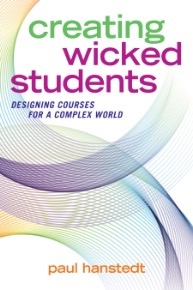
Book Reviews - 437 results
Select an item by clicking its checkbox
Creating Wicked Students: Designing Courses for a Complex World
Date Reviewed: September 6, 2018
Paul Hanstedt
Sterling, VA: Stylus Publishing, 2018 (x + 180 pages, ISBN 978-1-62036-697-4, $24.95) One might assume that a text called Creating Wicked Students would discuss types of “wicked” problems – complex social-environmental issues that cannot be solved with existing modes of inquiry and decision-making – that instructors might address through a problem-based learning approach. However, this work actually is an introduction ...
Creating Wicked Students: Designing Courses for a Complex World
Paul Hanstedt
Sterling, VA: Stylus Publishing, 2018 (x + 180 pages, ISBN 978-1-62036-697-4, $24.95)
One might assume that a text called Creating Wicked Students would discuss types of “wicked” problems – complex social-environmental issues that cannot be solved with existing modes of inquiry and decision-making – that instructors might address through a problem-based learning approach. However, this work actually is an introduction to course design most useful for beginning instructors or those redesigning their courses according to sound pedagogical principles. Situating himself against those who view higher education as solely preparing students for the workforce or transmitting content, Hanstedt emphasizes the importance of instilling a sense of authority in our students by helping them develop skills and attitudes that will empower them to make meaningful change in the world.
Hanstedt’s holistic vision of education includes attitudes and dispositions alongside skills and content mastery, and will likely resonate with instructors in religious studies and theology. Although he does not explicitly refer to our disciplines, he does offer examples, anecdotes, and insights from colleagues in a variety of fields and institutions, which is a strength of the book. He references seminal work in the scholarship of teaching and learning – including that of: George Kuh (2008, High-Impact Educational Practices, AACU); James Zull (2002, The Art of Changing the Brain, Stylus); and David Krathwohl (2002, “A revision of Bloom’s taxonomy,” Theory into Practice 41) – but does not engage with previous scholarship on wicked problems. Readers interested in learning more about pedagogical approaches to wicked problems could consult the work of the work of: Brown et al. (2010, Tackling Wicked Problems, Routledge); Carcasson (2017, “Deliberative Pedagogy as Critical Connective” in Deliberative Pedagogy, Michigan State University); or Lee (2016, “Systems Thinking,” in Resilience by Design, Springer).
This book could be useful as an introduction to course design for someone less familiar with the fundamentals, such as how to develop measurable learning outcomes, align course goals with institutional goals, nest content within higher-order goals, engage students’ prior knowledge, or incorporate applied learning. The structure of the book allows for one to follow it step-by-step as a course design manual, and it also includes recursive “intermissions” to encourage reflection along the way. In addition, his discussion of how to prompt critical thinking through multiple-choice exams offers helpful strategies for encouraging students to explain their thinking on ambiguous questions with follow-up questions that explain or justify their choice (92-98).

Specifications Grading: Restoring Rigor, Motivating Students, and Saving Faculty Time
Date Reviewed: April 23, 2015
Concerns about mastery of learning outcomes or competencies, grade inflation, student motivation, and faculty time compel reflection on how we assess students in higher education. In Specifications Grading, Nilson critiques the traditional, point-based grading system and argues that students should be assessed on whether they have mastered course learning outcomes. She proposes specifications (specs) grading as a positive alternative to the current grading system.
Nilson makes the case for specs grading in ten chapters. Chapter 1 examines critiques of the traditional grading system and offers fifteen criteria for judging a grading system. Chapter 2 briefly introduces learning outcomes and course design. In chapter 3, Nilson shows that grades should correspond to whether a student has mastered learning outcomes. Nilson ties grades to specific learning outcomes: a student can earn higher grades for demonstrating the amount of their learning, mastering more learning outcomes, or both (25). In chapter 4, Nilson argues that assessments should be graded pass/fail because this raises the expectation for a passing grade to the B-level. This also potentially reduces faculty time spent grading as it eliminates the need to justify partial credit. In chapter 5, Nilson outlines some aspects of specs grading: a single level rubric, faculty clarity on assignments and assessment, student choice, and opportunities to resubmit work. Chapter 6 describes how to convert specs grading to final course grades by either employing a point system for assessment or requiring students to complete certain assessments (bundles or modules) to achieve a particular course grade. Chapter 7 offers examples of courses that employ specs grading in diverse disciplines. After addressing theories of motivation, chapter 8 demonstrates how specs grading can motivate students to master learning through student choice. Chapter 9 explains how to design a specs grading course and introduce students to this grading system. Chapter 10 evaluates specifications grading according to the fifteen criteria set out in chapter 1.
Among its strengths, Specifications Grading offers experiential evidence from faculty as well as examples of specs grading from diverse disciplines. These examples encourage faculty to creatively re-envision their courses. Moreover, Nilson challenges faculty to draw on adult learning theories and motivational theory to promote mastery of course outcomes and encourage students to achieve their potential. Nonetheless, Nilson recognizes faculty’s hesitation in committing to a new grading system. As a result, Nilson describes (pure) specs grading courses as well as blended courses: courses that employ a mixture of point-based assessment and specs grading. These options enable faculty to slowly adjust to the new grading system or to attend to departmental or institutional grading expectations.
Nilson argues provocatively for the ways specifications grading motivates students and raises the standard of student work. To do this, faculty must know their expectations for student work and be clear in the directions for assignments. Moreover, faculty must expect students to fulfill those expectations – to take responsibility for their own grades and master course outcomes.

Creating Teacher Immediacy in Online Learning Environments
Date Reviewed: January 30, 2017
A key issue in distance education is how to establish a vital two-way, personal communication between learner and instructor. Borje Holmberg, among other theorists, argues that the primary role of an instructor is to empathize with the learner; imparting information is a secondary matter. What, then, are the most effective ways to form a dyadic alliance between a learner and instructor? This is the major question that D’Agustino’s Creating Teacher Intimacy in Online Learning Environments seeks to answer.
This is a reference work, so it can be read profitably article by article or completely. The volume begins with a helpful detailed table of contents that provides a brief synopsis of each chapter. There is also a useful foreword by Karen P. Kaun which underscores the importance of the human component in teaching and learning regardless of the instructional format. The preface speaks to the impact of the “interactive turn,” the “undesigned remainder,” and the “modelling function” in asynchronous learning. In addition, there is a brief description of each chapter that complements the summaries in the table of contents. Every chapter also starts with an abstract and an introduction.
Pedagogy, not technology, is the focus of each chapter. Therefore, this reference is valuable for course designers, media specialists, instructors, and researchers across a range of academic disciplines. That said, there are a few chapters that all will want to read and ponder.
Oliver Dreon’s “Building Teaching Presence in Online Classes,” for example, provides an overview of the main issues along with strategies that support learning and interaction. A list of design principles is included, suggestions for future research are indicated, and there is a concise paragraph of conclusions plus an extensive list of references. A central contention made by Dreon is that practices that contribute to high quality, traditional undergraduate instruction also apply to establishing meaningful instructor presence in online classes.
Many readers will also want to look closely at Caroline M. Crawford’s “Instructor Immediacy and Authenticity: Engaging in Cognitive Vulnerability within the Instructional Environment.” Often, learner success in an online course – synchronous or asynchronous – will largely depend on the instructor’s efforts to generate worthwhile interactive opportunities. These activities require that the instructor have a clear philosophical belief system united with an understanding of the learner’s cognitive vulnerability in an online environment. Crawford explores these core issues while calling for the development of a “talent propelled” instructional environment.
Neal Shambaugh’s “Interactivity and Immediacy in Online Academic Programs” addresses quality issues in higher education distance classes. This is an important theme because, as D’Agustino notes in the preface, “online learning still has a perceived lack of legitimacy” (xxiv). Shambaugh advocates interactivity as a method to counter this concern. He offers a list of best practices for creating and sustaining online immediacy. Then he sketches a series of recommendations for undergraduate, master’s, doctoral, and specialized programs, such as teacher education, certificates, and professional development.
There is an extensive compilation of references and notes about the contributors that conclude this collection. The references alone are an excellent guide for further research and course syllabi.

Are You Smart Enough? How Colleges' Obsession with Smartness Shortchanges Students
Date Reviewed: July 10, 2017
“Stop telling your children that they are smart,” is the new rage in parenting advice. Research has demonstrated that praising children for their smartness tends to undermine their performance. Kids who believe that success is due to innate ability also tend to think that failure is caused by innate inability. When they encounter hard tasks, they are prone to give up and to view themselves, or the task, as inept. Nearly every college professor has experienced the frustration of such students, who often feel that their smartness entitles them to automatic A’s on every assignment, regardless of the effort, accuracy, or sophistication of their work!
In Are You Smart Enough? veteran educational researcher Alexander W. Astin calls upon college faculty to recognize that our institutions have helped to create this problem. Looking at the primary measures that colleges utilize to evaluate their success – standardized test scores, retention and graduation rates, course grades and GPAs – Astin’s central claim is that postsecondary institutions are more focused upon identifying smartness than developing it. College rankings, for example, are heavily weighted toward the standardized test scores for incoming classes. Course grades and GPAs mainly serve to mark students’ progression toward degree completion, to identify low-performing students who may need to be dismissed, and to aid in admissions for graduate and professional schools. Standard metrics do not assess the information core to colleges’ mission: what students learn and when they acquire the knowledge. Postsecondary education, consequently, has become more concerned with identifying and acquiring smart students than with developing students’ intellectual and academic capabilities.
Astin places much of the responsibility for this preoccupation with smartness upon faculty. While faculty often complain about the culture of entitlement that exists among undergraduate and graduate students, we create this culture through our admissions and grading standards, which imply that our job is to reward – rather than enhance – smartness. Many faculty view their jobs primarily as imparters of specialized content knowledge; we expect students to already possess the analytical and communication skills necessary to acquire that knowledge when they enter our classrooms. Astin claims that faculty preoccupation with student smartness is a product of our preoccupation with our own, as evidenced by institutional processes for hiring, tenure, and promotion. Just as colleges expect incoming faculty to be fully formed experts capable of displaying our smartness, faculty expect students to be sufficiently formed when they enter our classrooms.
Astin does not merely critique the institutional culture; he provides concrete guidelines for shifting our focus to growing and developing student learning. In particular, he recommends utilizing narrative evaluations in course grading. He also advocates expanding our assessment of student development to include the affective outcomes that are often central to college mission statements: leadership, citizenship, and service. He writes that colleges should pay particular attention to students’ spiritual development, given that a central component of the college experience is students’ exploration of their sense of purpose, their moral and ethical commitments, and their self-development.
Astin’s text is a significant contribution to the emerging literature critiquing our culture’s obsession with innate ability. It explores themes similar to those in Carol Dweck’s bestselling book, Mindset (Random House, 2006), but unfortunately does so with less substance and more redundancy. It would have been helpful if Astin had integrated evidence from educational and neurological research to support his core assumption that intelligence can be, and should be, developed among young adults. He could also have provided more substantive suggestions for changing academic cultures, with attentiveness to not only admissions and grading, but also to student support services, academic advising, institutional effectiveness, faculty governance, development, and alumni relations.
Overall, Are You Smart Enough? is an important and thought-provoking text for postsecondary faculty. While primarily focused upon undergraduate institutions, its central argument is just as relevant to graduate and professional programs.

Beginning a Career in Academia: A Guide for Graduate Students of Color
Date Reviewed: September 18, 2016
Touting itself as “the first scholarly volume to exclusively mentor graduate students of color” (x), this collection of essays offers invaluable insights for navigating the academic job market and working as junior faculty.
This volume is divided into three sections. The six chapters comprising the first division, “Practical Advice for Finding Success in the Academic Job Market,” provide concrete examples of how to deal with various aspects of the job application process. For instance, Michelle Camacho outlines steps from submitting a CV to negotiating terms of hire. Her sample messages illustrate proper email etiquette.
The second part of the book, “Identity, Fit, Collegiality, and Secrets for Thriving in the Ivory Tower,” includes four chapters of advice for avoiding career derailments commonly faced by tenure-track faculty of color. Various professors share their experiences of both hardship and success. Nayeli Chavez-Dueñas and Hector Adames challenge the reader, via “ten reflective questions,” to introspect concerning motivations and commitment to a career in academia (124). Furthermore, their tables “Skills Required for Entry-Level Academic Positions and Alternatives to Strengthen Application” and “Seven Psychological Strengths of People of Color” (132-133) can be referenced daily, for goal setting and encouragement. Every academician would be wise to avoid the pitfalls Elwood Watson highlights in his essay “Fifteen Missteps That Can Derail Faculty Early in a Career.”
The final five chapters make up the segment entitled “Work-Life Balance: Strategies for Transitioning From Graduate School to the Classroom.” It addresses decisions that scholars of color should make early in their careers to effect sustainable work-life balance. The articles urge both students and faculty to develop healthful ways of being.
A few additions to the volume would enhance what is already a strong collection of essays. An article on the role of social media in the hiring and tenure process for scholars of color would be a welcome expansion. While Watson warns of the dangers of inappropriate social media posts (113), graduate students are also grappling with how to use social media to enhance career prospects. Similarly, a full chapter on crafting and presenting a conference paper would be an elucidating follow-up to Nadine Finigan-Carr and Natasha Brown’s insightful chapter “Navigating Professional Conferences.” Finally, while Tom Otieno’s essay “Transitioning Strategies from Graduate School to Early Career Faculty” explicates different types of academic institutions (74), an expanded orientation to the field would also be beneficial. This could include more explanation of the Carnegie Foundation for the Advancement of Teaching’s classification system (74) and definitions or etymologies of terms such as “research I universities” (9).
This volume is a great resource for new initiates to the academic job market and workplace, as well as for those who already have some familiarity or experience. The short, engaging essays, which can be read in any order, invite scholars to revisit this guide often for help to land a new job or maintain a healthy work-life balance.

